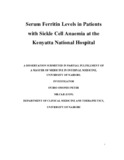| dc.contributor.author | Oyiro, Omondi P | |
| dc.date.accessioned | 2017-01-09T04:32:01Z | |
| dc.date.available | 2017-01-09T04:32:01Z | |
| dc.date.issued | 2016 | |
| dc.identifier.uri | http://hdl.handle.net/11295/99715 | |
| dc.description.abstract | Background: The iron levels in Sickle Cell Anaemia (SCA) are thought to be increased
as a result of the repeated red cell transfusion, haemolysis with subsequent recycling and
accumulation of iron. Red cell transfusion is used more frequently to prevent and treat the
complications of sickle cell disease. Studies have shown that the changes in iron status
that results from such therapy is associated with significant morbidity and mortality. This
study examined the serum ferritin as a marker of iron levels in patients with sickle cell
disease who receive chronic red blood cell transfusion.
Objective: The aim of this study was to assess the status of serum iron levels by
measurement of serum ferritin levels in patients with sickle cell Anaemia at Kenyatta
National Hospital.
Setting: The study was carried out at the Kenyatta National hospital Haematology clinic.
Design: Cross-sectional descriptive study
Materials and methods: This study enrolled 80 patients with sickle cell anaemia. History
and physical examination was done and recorded on a standard study questionnaire. Samples
of blood were then drawn for serum ferritin, full blood count including peripheral blood
film. Serum ferritin was assessed using enzyme immunoassay sandwich method with a
final fluorescent detection (ELFA) kits. Blood counts were done using the haematology
cell counter (CELL-DYN 1300) whiles the peripheral blood films were stained using May
Grunewald Giemsa method. Quality control measures were observed in all tests performed
by adhering to reagent manufacturers’ guidelines and standard specimen handling/laboratory
operating procedures, to ensure validity of results.
Results: Eighty clinically stable patients with SCA were studied. Thirty three were males
(41.3%) while Forty seven were females (58.7%). The mean age in the study population
were 19.7±5.5 years with the youngest being 13years and the oldest 37years. Serum ferritin
mean 939.25±668ng/ml , was found to be significantly elevated in 56 (70.5%) of our study
subjects while 24 had normal SF levels and none of them had low SF. Twenty five (31.3%)
who had very high SF, above 1000ng/ml, had also been transfused a mean of 15±8.2 units
of blood. There was a significant association between SF and the number of units of blood
transfused, p=<0.001.There was no demonstrable significant association between SF and
age, sex or red cell parameters.
Conclusion: This study demonstrated high level of serum ferritin in sickle cell anaemia
patients who had been transfused ≥15 units of blood over a period of five years. Overall
about a third of the study subjects had Serum Ferritin levels that required further
evaluation to find out if they had iron overload. | |
| dc.language.iso | en | en_US |
| dc.publisher | University of Nairobi | en_US |
| dc.rights | Attribution-NonCommercial-NoDerivs 3.0 United States | * |
| dc.rights.uri | http://creativecommons.org/licenses/by-nc-nd/3.0/us/ | * |
| dc.title | Serum ferritin levels in patients with sickle cell anaemia at the Kenyatta national hospital | en_US |
| dc.type | Thesis | en_US |
| dc.description.department | a
Department of Psychiatry, University of Nairobi, ; bDepartment of Mental Health, School of Medicine,
Moi University, Eldoret, Kenya | |


